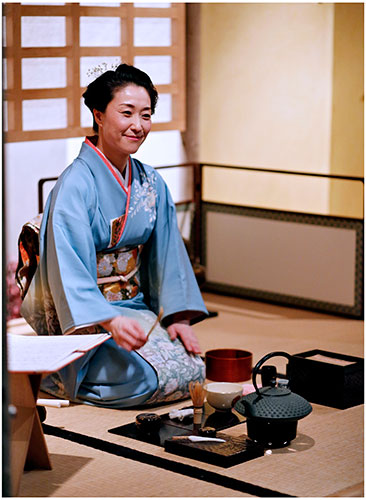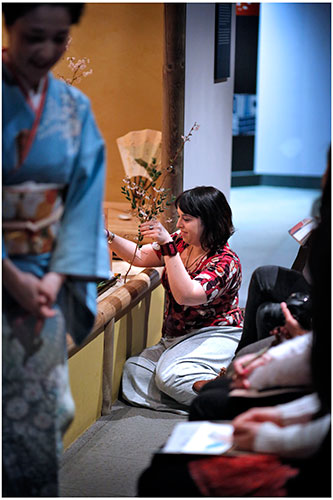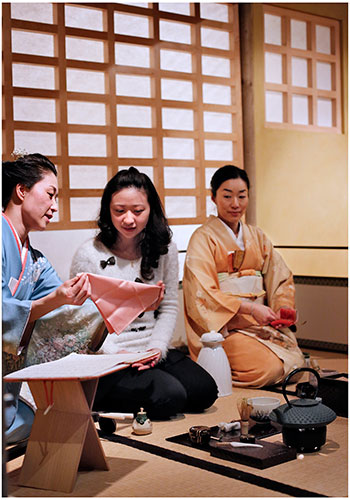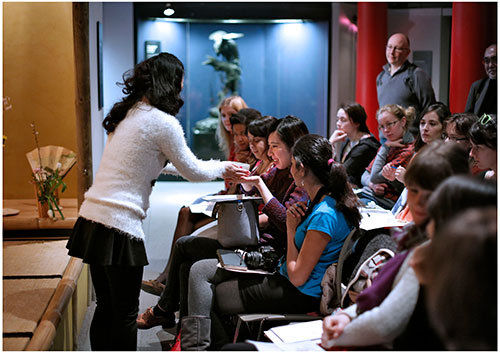Every year the University of Edinburgh holds an Innovative Learning Week, allowing students the opportunity to attend creative and experiential learning events. These open up new perspectives on their studies, inspiring debate and prompting future research.
National Museum of Scotland recently hosted a Japanese tea ceremony for students from the History of Art department, within the serene environment of the Japanese tea house (chashitsu) in the Lady Ivy Wu Looking East gallery.
The ceremony was led by Mio Shapley, a qualified Master in the Urasenke tradition. Hiromi Moffat set the atmosphere by playing the shamisen, a three-stringed Japanese instrument played with a large plectrum (bachi). All four participants in the ceremony wore elegant kimono and hair ornaments.

Tea has been drunk ceremonially in Japan since at least the 8th century, although the basis of the existing tea ceremony probably dates from the 16th century. The highly symbolic ritual follows prescribed actions and gestures, demonstrative of purity and balance.
Traditionally the ceremony takes place within a tea house; a deliberately simple room usually set within an apparently uncultivated garden. It has no furnishings beyond the traditional tatami straw matting on the floor. A small sliding door requires the guest to bow humbly and enter on their knees, before symbolically closing the door to the outside world behind them. The room often contains an alcove used to display a naturalistic flower arrangement, and a hanging scroll with either a painting or calligraphy appropriate to the season or occasion. At the start of our ceremony, one of the students was asked to arrange seasonal foliage in a vase, and place it in the alcove.

Essential equipment for traditional tea preparation includes: the tea bowl (chawan) for drinking; the tea whisk (chasen) carved from a single piece of bamboo; the tea scoop (chashaku) and tea caddy (usuchaki or cha-ire), together with a cloth for wiping the bowl clean (chakin). Also necessary are a kettle (kama) and brazier (furo), and a long bamboo ladle (hishaku) for scooping boiling water from the kettle to the tea bowl. Additional items include storage containers made of natural materials such as wood or bamboo, and cloths for ritual cleaning and handling of hot items. All utensils are chosen with consideration for quality and aesthetics; some may be antique, passed down through generations. All are handled with great care and respect.

The tea ceremony is highly spiritual and closely linked to Zen Buddhism. It is conducted in silence, and the calm, deliberate movements create a meditative atmosphere. The central tenets of the ceremony are harmony, respect, purity and tranquillity; participants also endeavour to cultivate a greater awareness of themselves, as part of their personal progression towards spiritual enlightenment.
Following the silent demonstration, a student was invited to prepare a second bowl of tea, whilst the first bowl was passed between her colleagues, accompanied by various traditional sweets (wagashi).


We would like to thank Mio and her colleagues for offering us a short glimpse into an ancient cultural tradition. This gave us all a moment to pause, reflect, savour, connect with each other, and then carry within us back into the pleasures and distractions of the everyday world.
